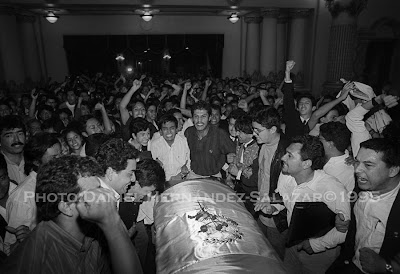Familiares de personas desaparecidas durante la guerra civil, manifiestan frente a la Catedral de Guatemala. / Relatives of missing persons during the civil war demonstrate in front of Guatemala's Cathedral.
Marcha contra el olvido. Parque Central, Guatemala, 1985. / March against oblivion. Central Park, Guatemala, 1985.
Abuela con los retratos de sus nietos desaparecidos durante la represión en Guatemala. Escuela Politécnica del ejército, Guatemala, 1999. / Grandmother with portraits of her grandchildren missing during the repression years in Guatemala. Military Academy, Guatemala City, 1999.Familiares de trabajadores y estudiantes desaparecidos durante la guerra civil en Guatemala. Sede de los sindicatos, Guatemala, 1988. / Relatives of workers and students missing during the civil war in Guatemala. Unions headquarter, Guatemala City, 1988.
Viudas de campesinos de la aldea Pujujil II, lloran frente a los restos exhumados e identificados de sus familiares, asesinados durante la guerra civil. Catedral de Guatemala, 1992. / Widows of assasinated campesinos cry in front of the identified remains of their loved ones after being exhumed. Guatemala Cathedral, 1992.
Viudas y Madres de campesinos asesinados por el ejército guatemalteco salen de la misa oficiada antes del entierro. Santiago Atitlán, Guatemala, 3 de diciembre de 1990. / Widows and mothers of campesinos assasinated by the guatemalan army leave the burial mass. Santiago Atitlán, Guatemala, December 3 1990.
Un soldado del ejército guatemalteco sobre los restos de un puente volado por la guerrilla. Río Mocá, Escuintla, Guatemala, 1990. / Guatemalan army soldier on the remains of a bridge blow up by guerrilla members. Mocá river, Escuintla, Guatemala, 1990.
Soldados del batallón élite "Kaibil" marchan en el "día del ejército". Los Kaibiles han sido acusados de cometer los peores abusos en contra de la población civil durante la guerra interna de Guatemala. / Soldiers from the elite Kaibil batallion march on "army's day". Kaibil members have been acussed of commiting the worst abusses against the civilian population during Guatemala's armed conflict.
Rigoberta Menchú Tum, Premio Nóbel de la Paz 1992, asiste por primera vez a una exhumación de restos de personas asesinadas durante la guerra civil guatemalteca. Aldea Xiquín Sanahí, Comalapa, Chimaltenango, 5 de marzo de 2002. / Rigoberta Menchú Tum 1992 Nobel Peace Prize winner attends for the first time an exhumation of victims of the civil war in Guatemala. Xiquin Sanahi, Comalapa, Chimaltenango, March 5 2002.
Sacerdotes Mayas inciensan los restos de personas asesinadas en la masacre de Panzós en 1978. Esta masacre fué quizá la primera en tener resonancia nacional e internacional. Alta Verapaz, Guatemala, 1997. / Mayan priests wave incense over the remains of persons assasinated in 1978 at the Panzos massacre. This massacre was perhaps the first to gain national and international notoriety. Alta Verapaz, Guatemala, 1997.
Una mujer señala los restos de un familiar durante la exhumación de los restos en una fosa clandestina. Aldea El Adelanto, Sololá, Guatemala 2008. / A woman points out the remains of a relative during the exhumation in a clandestine grave. El Adelanto, Sololá, Guatemala 2008
Un hombre y sus hijas reciben los restos de un familiar desaparecido y asesinado. Detrás se observan decenas de cajas conteniendo restos de personas asesinadas. Nebaj, Quiché, Guatemala, 2000. / A man and his daughters receive back the remains of a disappeared and assasinated relative. Behind him are dozens of boxes containing remains of assasinated persons. Nebaj, Quiché, Guatemala, 2000.
Una mujer que lleva la fotografía de una pariente desaparecida y asesinada en la guerra civil de Guatemala, participa en la procesión funeraria de cientos de victimas. Nebaj, Quiché, Guatemala, 2000. / A woman carrying the photograph of a relative who dissapeared and was assassinated during the Guatemalan civil war participates en the funeral procession for hundreds of victims. Nebaj, Quiché, Guatemala, 2000.Miles de personas participan en la "Marcha del silencio" portando afiches del Proyecto de Recuperación de la Memoria Histórica (REMHI) dos días después del brutal asesinato de Monseñor Juan Gerardi, Director del proyecto. Guatemala 28 de abril de 1998. / Thousands of participants in the "March of Silence" carry posters of the Recovery of Historical memory Project (REMHI) two days of the brutal assasination of the Director of the project Monsignor Juan Gerardi. April26 1998.
Jóvenes portando afiches del Proyecto de Recuperación de la Memoria Histórica (REMHI), gritan consignas en la marcha del 1o de mayo, Día Internacional del Trabajo, demandando justicia por el asesinato de Monseñor Juan Gerardi cometido cinco días antes. Guatemala, 1o. de mayo de 1998. / Young people carrying posters of the Recovery of Historical Memory (REMHI) Project shout slogans during the International Labor Day march asking for justice for Monsignor Juan Gerardi's assassination happened five days before. Guatemala May 1st. 1998.
Estudiantes, intelectuales y obreros saltan alrededor del féretro con los restos del Presidente Jacobo Arbenz durante los actos de repatriación a Guatemala. Arbenz fué derrocado por la CIA y la oligarquía guatemalteca en 1954. / Students, intellectuals and workers jump around the coffin with the remains of President Jacobo Arbenz during the ceremonies of repatriation to Guatemala. Arbenz was ousted from office by the CIA and Guatemalan oligarchy in 1954. National Palace, Guatemala City, 1995.
Una niña participa en la marcha conmemorativa del 25 aniversario de la quema de la Embajada de España por parte de fuerzas de seguridad del Estado Guatemalteco en 1980. En esa masacre murieron calcinadas 37 personas incluyendo el Padre de Rigoberta Menchú. Guatemala 31 de enero de 2005. / A child participates in the commemorative march on the 25th anniversary of the attack on the Spanish Embassy by Guatemalan State security forces in 1980. In that massacre died 37 persons including Rigoberta Menchú's Father. Guatemala, January 31 2005.
El Padre de un migante asesinado en México cuando viajaba hacia Estados Unidos se cubre por temor parcialmente el rostro con el retrato de su hijo. El Progreso, Guatemala, 2010. / The father of a migrant assassinated in Mexico on his way to the USA covers fearfully his face with his son's portrait. El Progeso, Guatemala, 2010.





















No hay comentarios.:
Publicar un comentario